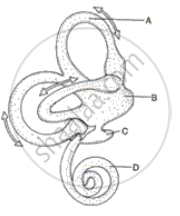Advertisements
Advertisements
प्रश्न
Explain the following:
Mechanism through which a sound produces a nerve impulse in the inner ear.
उत्तर
The pinna of the external ear collects the sound waves and directs them to the tympanic membrane (ear drum) via the external auditory canal. The ear drum then vibrates the sound waves and conducts them to the internal ear through the ear ossicles. The ear ossicles increase the intensity of the sound waves. These vibrating sound waves are conducted through the oval window to the fluid in the cochlea. Consequently, a movement is created in the lymph. This movement produces vibrations in the basilar membrane, which in turn stimulate the auditory hair cells. These cells generate a nerve impulse, conducting it to the auditory cortex of the brain via afferent fibres. The auditory cortex region interprets the nerve impulse and sound is recognised.
APPEARS IN
संबंधित प्रश्न
Time taken by an object to complete one oscillation is called ___________.
The unit of frequency is ______.
Deafness is causal due to the rupturing of the Pinna.
(i) Draw a well labelled diagram of the membranous labyrinth found in the inner ear.
(ii) Based on the diagram drawn above in (i) give a suitable term for each of the following descriptions :
1. The sensory cells that helps in hearing.
2. The part that is responsible for static balance of the body.
3. The membrane covered opening that connects the middle ear to the inner ear.
4. The fluid present in the middle chamber of cochlea.
5. The structure that maintains dynamic equilibrium of the body.
A fluid that occupies the larger cavity of the eye ball behind the lens is
___________.
Perilymph or endolymph (Which one surrounds the organ of Corti ?)
Differentiate between members of the following pair with reference to what is asked in bracket.
Dynamic balance and static balance (Definition)
Mention, where in living organism is the following located and state their main function:
Organ of corti
With reference to the human ear, answer the question that follow:
Give the technical term for the structure found in the inner ear.
With reference to the human ear, answer the question that follow:
Name the three small bones present in the middle ear. What is the biological term for them collectively ?
With reference to the human ear, answer the question that follow:
Name the part of the ear associated with
(1) static balance
(2) hearing
(3) dynamic balance.
Name the part of the ear associated with dynamic balance.
Name the nerve which carries electrical impulses from the cochlea of ear to the brain.
Name the following:
Part of internal ear related to balance.
The diagram alongside represents the structure found in the inner ear. Study the same and then answer the questions that follow:
(i) Name the parts labelled A, B, C and D.
(ii) Name the parts of the ear responsible for transmitting impulses to the brain.
(iii) Name the part labelled above which is responsible for:
1. Static equilibrium. 2. Dynamic equilibrium. 3. Hearing
(iv) Name the audio receptor cells which pick up vibrations.
(v) Name the fluid present in the inner ear.

Given below is a diagram of a part of the human ear. Study the same and answer the question that follow:

State the functions of the parts labeled 'A' and 'B'.
Given below is a diagram of a part of the human ear. Study the same and answer the question that follow:

Name the audio receptor region present in the part labeled 'A'.
List the causes of noise pollution.
The spiral organ possessing sensory cells for hearing is ______.
With reference to human ear answer the question that follow:
Name the part of the ear associated with dynamic balance.
